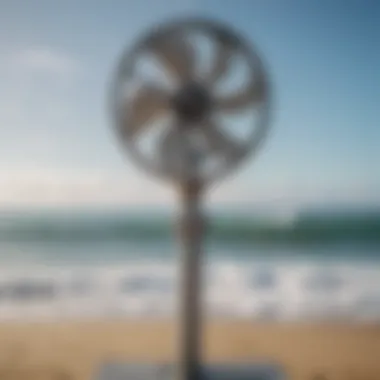Understanding Wind Measurement Tools for Surfing


Intro
When it comes to catching the perfect wave, understanding the role of wind is crucial for surfers. Wind has profound effects on wave formation, altering their size, shape, and overall quality. As many experienced surfers would tell you, recognizing wind patterns can make the difference between an enjoyable session and a day spent scratching in the shallows. The right set of wind measurement instruments can provide valuable insights into the gusts and breezes that will affect surf conditions. This article explores various tools that surfers can use to gauge wind speed and direction and discusses how these measurements can enhance decision-making and overall experience on the water.
Wind Measurement Instruments
Surfers traditionally rely on several key instruments to help assess wind conditions. Understanding these tools opens up a world of information, allowing surfers to optimize their time spent in the water.
Anemometers
Anemometers are the bread and butter for many weather enthusiasts and surfers alike. As simple as a spinning cup design or more advanced digital models, they measure wind speed accurately. The typical handheld version offers portability, which is invaluable for those on the go. Many surfers prefer using anemometers integrated into mobile apps, allowing them to track conditions in real time.
Wind Vanes
Wind vanes complement anemometers by measuring wind direction. It's like having a compass that tells you where the wind’s coming from, playin' a key role in understanding how it’ll impact the surf. These instruments are particularly useful for assessing whether the wind is onshore, offshore, or side-shore, all of which affect wave conditions differently. Surfers can position themselves according to the prevailing winds for the best wave potential.
Weather Apps
In today’s digital age, weather apps are game-changers for surfers. By aggregating data from multiple sources, these apps provide forecasts and real-time updates, giving a complete picture of both wind and wave conditions. Popular options like Surfer’s Paradise or Windy bring a wealth of information to your fingertips, helping to make informed decisions before heading out.
Practical Applications
Understanding how to use these instruments can significantly enhance a surfer's experience.
Assessing Conditions
To make the most of a session, surfers check the forecast that includes wind speed and direction. For instance, if the wind is blowing offshore at 15 mph, it typically means cleaner waves. The surfer can utilize this information to plan their trip to the beach accordingly.
Timing Your Sessions
By staying aware of changing wind conditions, surfers can time their sessions perfectly. Early mornings often witness lighter winds, ideal for flat water. In contrast, a late-night session can uncover beautifully wind-sculpted waves that the wind picked up throughout the day. By understanding these patterns, surfers can ride at optimal times.
"The wind is like a whisper from the sea, guiding surfers towards their next unforgettable ride."
Surfers who embrace technology and the knowledge behind wind measurement tools are not just informed; they are ready to maximize their performance in the water. By mastering these instruments, surfers can surf smarter, not harder.
Ending
Knowing how wind measurement instruments work is critical for surfers of all levels. Not only can it transform your surfing experience, but it also ensures safety and better decision-making. As every surfer knows, riding the waves is as much about understanding nature as it is about skill. So next time you're itching to hit the waves, spare a moment to check the wind conditions—it might just lead you to the ride of your life.
Foreword to Wind Measurement in Surfing
Wind changes the game for surfers, acting as both a friend and foe. Understanding how to measure wind isn't just a technical detail; it’s crucial for anyone looking to catch the perfect wave. In surfing, wind impacts wave formation, affects water surface conditions, and ultimately dictates the ride. The wind dictates whether the swell is clean, choppy, or downright unrideable. So, getting a handle on wind conditions isn’t just a smart move; it’s a pivotal step toward enhancing your surfing experience.
When surfers step out onto the water, they aren�’t just riding waves; they’re riding momentum, and wind plays a substantial role in how that momentum is formed. The right wind conditions can transform a mediocre surf session into an exhilarating ride.
Importance of Wind for Surf Conditions
Wind is a silent force that can enhance or ruin a surfing trip. It affects everything from wave height to the terrain of the ocean surface. Here are a few reasons why wind is so essential:
- Wave Shape and Size: Offshore winds can create perfectly shaped waves, while onshore winds can result in sloppy, disorganized swell.
- Swell Direction: Understanding wind direction is key to predicting wave formation. A north wind may enhance swell coming from the west.
- Local Conditions: Winds can vary significantly based on geographical features, affecting local surf spots differently.
Without wind assessments, surfers may find themselves facing unpredictable conditions that can lead to missed opportunities or, worse, unsafe situations.
Overview of Wind Measurement Instruments
To navigate the often unpredictable nature of wind, several instruments have been developed to measure wind speed and direction. Here’s a brief overview of the main types:
- Anemometers: These devices measure wind speed, providing real-time data about how fast the wind is blowing. They often come in both handheld and stationary varieties.
- Wind Vanes: Used in tandem with anemometers, wind vanes track wind direction, showing surfers the exact way the wind blows.
- Sonic Anemometers: These are advanced tools that use sound waves to measure wind speed and direction more accurately. They’re generally used in research or competitive settings.
- Portable Wind Meters: Ideal for surfers on the go, these small devices provide quick and easy wind measurements, making them ideal for surf trips.
Knowing how to use these tools can give surfers an edge, allowing them to make informed decisions about when and where to surf, ultimately leading to a better overall experience on the water.
Types of Wind Measurement Instruments
Understanding the various types of wind measurement instruments is crucial for surfers who rely on accurate data to determine surfing conditions. Each instrument serves a specific purpose, capturing unique aspects of wind dynamics, which can directly affect wave quality and ultimately, the surfing experience. Familiarizing oneself with these tools not only enhances decision-making abilities but also promotes a safer approach to the sport.


Anemometers
Anemometers are often seen as the bread and butter of wind measurement. These devices gauge wind speed and are typically categorized into different types, including cup, vane, and hot-wire anemometers. Each variation operates on distinct principles, yet they all share the primary goal of delivering precise wind velocity readings.
For surfers, knowing the wind speed is essential, as it influences wave formation and stability. Varying wind strengths can create drastic changes in surf conditions.
- Cup anemometers utilize rotating cups to measure wind speed, making them reliable for field measurement.
- Vane anemometers, on the other hand, combine wind direction, providing a more comprehensive picture.
- Hot-wire anemometers excel in laboratory environments due to their sensitivity, but they may not be as practical for real-time surfing applications.
Regardless of type, anemometers must be regularly calibrated to ensure accurate readings, as even minor discrepancies can lead to misguided surfing decisions.
Wind Vanes
Wind vanes are effective tools designed primarily to indicate wind direction. They might appear simple but play a pivotal role in understanding how wind interacts with the ocean. For surfers, wind direction is fundamental in determining the favorable conditions for catching waves.
A well-positioned wind vane will provide crucial data for evaluating how the wind might affect incoming swells.
Key aspects include:
- Orientation of the wind relative to the shoreline, which can vastly alter wave behavior.
- The relationship between onshore and offshore winds; onshore winds are often favorable for surfing, while offshore winds can create challenging conditions.
Some advanced wind vanes integrate GPS and connectivity features, giving surfers the ability to track wind patterns over time, allowing for better long-term planning.
Sonic Anemometers
Taking technology a step further, sonic anemometers are remarkable instruments that provide high-accuracy wind measurements by using sound waves. They bounce sound off the air, measuring how well those waves travel, which directly correlates with wind speed and direction.
While these devices tend to be on the pricier side, their precision makes them invaluable for competitive surfers keen on optimizing performance. Sonic anemometers can also aggregate data quickly, giving real-time feedback, which can be instrumental in competitions or serious training sessions.
Using a sonic anemometer allows surfers to:
- Monitor minute changes in wind conditions, which could influence heat outcomes.
- Analyze data over extended periods to spot trends in local wind patterns and adjust accordingly.
Portable Wind Meters
For surfers constantly on the go, portable wind meters offer a convenient solution for measuring wind conditions without the bulk of traditional equipment. These compact devices can easily fit in a pocket or a surf pack, allowing for quick checks right before heading into the water.
Most portable wind meters measure both wind speed and direction and come with screens that display these readings clearly. Their effectiveness, while undoubtedly useful for recreational surfers, also covers professionals who might be out scouting new spots.
Advantages of portable wind meters:
- Immediate feedback on current conditions, helping in quick decision making.
- Versatility in usage, as they can also serve for other outdoor activities, like hiking or biking.
"Using the right wind measurement tool is like having a fifth sense in surfing. You can read the ocean’s mood before you even touch the water."
In summary, whether it's an anemometer, wind vane, sonic anemometer, or a portable wind meter, each tool offers distinct benefits to surfers. Understanding these instruments empowers surfers to make informed decisions that enhance their time on the waves.
Understanding Wind Speed Measurements
Understanding wind speed is crucial for surfers. It can mean the difference between a day of perfect waves and one filled with frustration. Accurate measurements of wind speed help surfers assess conditions more effectively, allowing them to make informed decisions about when and where to hit the waves. With this knowledge, surfers can improve their riding experience and even enhance their safety by recognizing dangerous conditions.
Units of Measurement
When it comes to wind speed, there are several standard units of measurement that surfers will encounter. The most common include:
- Miles Per Hour (mph): Popular in the United States, this unit represents the number of miles traveled in one hour. Many surfers find it intuitive, as they often use mph for other speed measurements.
- Kilometers Per Hour (km/h): This unit is widely used outside of the U.S. and is a part of the metric system. Knowing how to convert between mph and km/h can help surfers understand reports from different regions.
- Meters Per Second (m/s): Commonly used in scientific contexts, this unit expresses wind speed in terms of meters traveled in one second. It’s less common among casual surfers but essential for those digging into meteorological data.
Converting between these units is relatively straightforward. For instance, 1 mph is approximately 0.447 m/s, and 1 km/h equals about 0.277 m/s. Knowing these conversions can better help surfers interpret local reports.
Factors Affecting Wind Speed
Surfers need to understand that wind speed is not just a fixed number; various environmental factors can influence it. Some of these include:
- Local Geography: Hills, mountains, or tall buildings can block or funnel wind, creating varied wind conditions even in a localized area. A coastline surrounded by cliffs, for example, might experience inconsistent wind while an open beach might have more uniform conditions.
- Temperature Differences: Warm air rises, creating areas of low pressure. Wind flows from high-pressure areas to low-pressure ones. This means that as the sun heats the land and the water warms up, winds can shift throughout the day, affecting surf conditions.
- Seasonal Variations: Wind patterns often shift with the seasons. Spring and fall can bring different wind speeds in comparison to summer due to weather systems that move through. Understanding these seasonal shifts can help surfers anticipate better conditions.
- Time of Day: During the day, changes in temperature can lead to variability in wind speed, especially with land and sea breezes. Knowing that the wind may pick up as the day warms could help surfers plan their sessions accordingly.
"Wind is not just a predictable force; it’s a complex ballet of nature influenced by geography and temperature that surfers must learn to dance with."
By keeping these factors in mind, surfers can hone their understanding of wind speed measurements, leading to smarter, safer surfing experiences.


Wind Direction and Its Impact
Wind direction plays a pivotal role in surfing, shaping not just the waves but the overall surfing experience. It influences the types and quality of the waves that break on the shore, which can ultimately determine whether a surf session is fruitful or a total washout. Understanding wind direction isn't merely a matter of knowing where the breeze is blowing from; it encompasses the art of reading the ocean and predicting how the surf conditions will unfold.
Significance of Wind Direction for Surfing
When it comes to surfing, the wind can be a friend or a foe. The significance of wind direction can be broken down into a few key areas:
- Wave Formation: Offshore winds, those blowing from land out to sea, typically produce cleaner, more organized waves. These winds help to groom the surface of the water, making the waves more ridable. On the flip side, onshore winds blow toward the shore and can create choppy, less predictable conditions that can lead to frustrating sessions.
- Surf Zone Dynamics: Wind direction influences the currents and rip tides that surfers face. A shift in the wind can alter the shape of sandbars and wave breaks, directly impacting where surfers can catch their rides.
- Safety Precautions: Knowing wind direction aids in identifying potential hazards like sudden changes in tide. For instance, a strong onshore wind can make it easier for riptides to form, which can pose risks to inexperienced surfers or those unprepared for rough conditions.
As surfers, recognizing these factors and adjusting accordingly enhances not only our performance but also our safety.
Common Wind Directions and Wave Patterns
Different wind directions foster various wave patterns that surfers can leverage to their advantage.
- Offshore Winds (Blowing from Land to Sea): This wind direction tends to favor surfers. Waves formed under these conditions often have a smooth surface, making it easier to perform tricks and maintain stability on the board.
- Onshore Winds (Blowing from Sea to Land): This is less desirable for surfers. Waves may be inconsistent and choppy, affecting their overall quality and breaking pattern. Surfing under onshore conditions can lead to a battle against the surf rather than riding it.
- Cross-Shore Winds: These winds, blowing parallel to the coast, can create unique surf conditions. Depending on the alignment of the coastline and the angle of the wind, this can either be beneficial or detrimental to the surf experience.
- Land Breezes: During the night, winds can shift back toward the land, potentially affecting the early morning surf. However, these breezes rarely impact the surf significantly compared to stronger coastal winds during the day.
"The direction of the wind can alter not just the waves but the entire atmosphere of a surfing session."
Understanding these wind patterns is crucial for surf forecasting and can make the difference between a day filled with joyful rides or one spent on dry land. Surfers often rely on an instinctive sense of wind direction, combined with knowledge gained through experience, to help navigate the waves. Ultimately, it’s about reading the conditions and adjusting to nature's whims.
Practical Applications for Surfers
In the ever-evolving world of surfing, an astute understanding of wind measurement can be the difference between a good day on the waves and a missed opportunity. The dynamic relationship between wind and surf conditions is not just a matter of chance; it’s science at play. Thus, grasping how to effectively utilize wind measurement tools is crucial for surfers of all skill levels. The practical applications of these instruments extend beyond mere curiosity; they empower surfers to make informed decisions that can significantly enhance their experience.
Using Apps for Wind Measurement
The advent of technology has brought forth a wave of innovative applications specifically designed to aid surfers in monitoring wind conditions. These apps serve as digital companions, providing real-time updates on wind speed and direction, as well as surf forecasts.
For example, apps like Windy or Surfline can be invaluable resources for surfers. By inputting their location, users receive pertinent data regarding local wind conditions that can affect wave quality.
- Real-time Alerts: Many apps offer notifications for sudden changes in wind patterns, allowing surfers to stay one step ahead.
- Predictive Models: Some platforms leverage data from weather stations to deliver forecasts that include expected wind shifts based on time of day and weather changes.
- User-Friendly Interfaces: Features such as interactive maps and easy-to-read graphs make it accessible even for those unfamiliar with meteorological data.
By adopting these practical tools, surfers can not only plan their sessions more effectively but also adjust their strategies in response to changing conditions.
Interpreting Data for Surf Conditions
Understanding how to interpret wind data is equally as essential as accessing it. Knowledge of surf conditions requires more than a simple glance at wind speed; it demands a deeper understanding of how various factors interplay to influence the surf.
- Wind Speed and Wave Quality: Generally, stronger winds can create bigger waves, but they can also lead to choppy and less rideable conditions. Surfing in winds exceeding a certain threshold, usually around 15 knots, can make for a jarring experience, especially for less experienced surfers.
- Wind Direction Impact: The angle from which the wind blows plays a critical role in shaping the waves. A onshore wind can flatten waves while offshore winds help them maintain their form, leading to cleaner, more manageable conditions.
By becoming adept at interpreting these data points, surfers can refine their approach—whether choosing to paddling out in bumpy conditions or waiting for the perfect offshore day.
"Wind is the silent architect of every wave; understanding it is key to mastering the surf."
Wind Measurement and Safety Considerations
Wind measurement is not merely a technicality for surfers; it plays a pivotal role in ensuring their safety on the water. As every seasoned surfer will tell you, understanding wind conditions can sometimes mean the difference between a thrilling ride and a precarious situation. High winds can create choppy waters that are difficult to navigate, while shifts in wind direction can lead to sudden changes in wave behavior. Familiarity with wind measurement tools thus becomes essential—a tool that can empower surfers to make informed decisions, thereby reducing risk.
Understanding Wind Hazards
Wind hazards refer to the various dangers that can arise from unpredictable wind conditions while surfing. These might include strong gusts that can topple even the most experienced surfers, or sudden shifts that can cause waves to break unexpectedly. For instance, if a surfer is unaware of an approaching storm front, they may find themselves caught in shifting winds that can generate powerful, dangerous swell.
Here are some common wind-related hazards surfers should be wary of:
- Strong Downwind Conditions: These can propel surfers into rocky areas or crowded spots, increasing the risk of collision.
- Crosswinds: “Side-on” winds may push surfers off course, making it tough to catch waves effectively.
- Wind Shadow Effects: Areas protected from the wind may suddenly expose surfers to rough conditions just beyond their safe zone.
Understanding these hazards is crucial for planning a successful and safe surfing session. By leveraging wind measurement instruments, surfers can gather data on current conditions, allowing them to anticipate and mitigate potential risks.
Preparing for Changing Conditions
Being prepared for changing conditions is essential for any surfer looking to have a safe experience on the waves. Wind patterns are notoriously fickle, and even a seemingly calm day can turn chaotic in the blink of an eye. Here are a few strategies to keep in mind:
- Regularly Monitor Wind Reports: Use various apps or websites dedicated to live wind and weather reports. By having up-to-date information, surfers can plan their outings around favorable conditions.
- Learn to Read Natural Indicators: The sky and the ocean have a language of their own. Understanding changes in wave patterns, cloud formations, or even the behavior of other surfers can provide critical clues about pending wind changes.
- Keep Safety Gear Ready: Equipment like leashes and flotation devices should always be on hand, particularly when venturing into more unpredictable waters.
- Know Your Limits: It's easy to get carried away by the excitement of surfing; however, limiting holds crucial. If the wind picks up more than you feel comfortable with, it’s wise to call it a day.
Always remember, safety first! A good session is worth nothing if it leaves you vulnerable to harm.


With a thorough understanding of wind measurement instruments and their implications, surfers can enhance not just their experience, but also their safety on the water.
Technological Advances in Wind Measurement
The realm of wind measurement instruments has seen a seismic shift in technology over the recent years. This evolution is vital for surfers, as the precision of wind data directly impacts surf conditions, wave formation, and ultimately the entire surfing experience. As the sport continues to grow, so does the need for more accurate, versatile, and user-friendly wind measurement tools. The advancements are not just for convenience; they inform better decision-making, safety, and performance on the water.
In this context, various innovative technologies are reshaping how surfers assess wind conditions. Understanding these advances not only allows surfers to select the right instruments but also enables them to grasp the complexities of wind patterns and their effects on the ocean.
Innovative Technologies in Use
Today’s market has a plethora of sophisticated wind measurement tools. These innovations bring a new level of accuracy and user engagement. Here are a few notable examples:
- Smartphone Apps: Several apps specially designed for surfers incorporate advanced algorithms and access to real-time data. These apps often pull information from numerous weather stations and integrate it with user-friendly interfaces. They can provide live updates on wind speed, direction, and other pertinent conditions. As a bonus, many of these apps allow surfers to set alerts for specific wind conditions, ensuring they don’t miss the perfect wave.
- IoT-Enabled Devices: Internet of Things (IoT) technology has trickled down into wind measuring instruments. Devices can connect to smartphones or smartwatches, providing immediate data transmission. This not only enhances situational awareness but also enables surfers to make informed decisions based on real-time conditions without needing to be physically present.
- Advanced Anemometers: New designs of anemometers now combine traditional spinning mechanisms with digital sensors. These devices can measure wind speed with extraordinary accuracy, even in turbulent conditions. Many anemometers now come with Bluetooth connectivity, allowing surfers to monitor data remotely.
"Embracing new technology is essential, not just for the convenience it offers but for the safety it ensures on the unpredictable waves."
Future Trends in Wind Measurement Tools
As we peer into the crystal ball of technological advancements in wind measurement, several intriguing trends appear on the horizon. These burgeoning technologies could further revolutionize how surfers interact with ocean conditions.
- Artificial Intelligence: Imagine an app where AI algorithms analyze historical wind data, surf patterns, and even seasonal trends. Surfers could receive personalized forecasts that consider individual surfing preferences. For instance, a surfer could input their desired wave conditions, and the app would suggest the best times and locations to catch those waves based on analyzed data.
- Augmented Reality (AR): AR tools could provide surfers with a real-time overlay of wind measurements directly onto their view of the ocean. Such technology could enhance situational awareness, allowing for quick assessments of changing conditions while out on the water.
- Drone Technology: Drones can be utilized not just for aerial photography but also for detailed wind analysis. They can fly over surf spots and gather actionable data about wind patterns and atmospheric conditions. The data collected could be instantly fed into analytical tools, providing surfers with insights that are usually hard to obtain.
Overall, the continuous innovation in wind measurement instruments is not merely a product of technological advancement; it is in direct response to the changing needs of surfers seeking to maximize their experience on the water. Keeping abreast of these technological advancements is essential for surfers, as it ensures they are not left in the dust as the waves roll in.
Case Studies: Wind Data in Surf Competitions
In the competitive world of surfing, knowing how the wind behaves can make or break a performance. Case studies focusing on wind data are crucial, as they provide insights that not only inform surfers but also influence the structure of competition heats. This section dives into the significance of analyzing wind data in surf events, highlighting its multifaceted role in shaping both strategies and outcomes.
Impact on Competition Outcomes
The correlation between wind patterns and competition outcomes can sometimes be as clear as day. For instance, different winds can create varying conditions in the surf, which directly affects the wave quality. When the wind blows offshore, waves typically break cleaner and create better rides. Conversely, onshore winds can lead to choppy water and less favorable conditions.
In notable competitions such as the World Surf League events, these factors play a pivotal role. A surfer might capitalize on favorable offshore winds, allowing them to execute more complex maneuvers. In contrast, those less adept at handling onshore conditions may struggle, directly influencing their scores.
The understanding of wind data leads to strategic planning for competitors. For instance, surfers often look at wind forecast data before competitions, leading to tactical decisions regarding which heats to enter and predicting their performances against opponents. This awareness can mean the difference between a confident ride and a missed opportunity.
"Wind factors in surfing are as vital as a quarterback's decisions on the field—hold the skill, and you can make a winning play."
Analyzing Historical Data
Diving deeper into historical wind data allows for a broader understanding of how conditions have impacted past competitions. By scrutinizing records and trends, teams and individual surfers can pinpoint the effects of wind on performance.
For instance, analyzing past events where offshore winds prevailed might show a pattern where certain surfers consistently thrived under those conditions. Similarly, exploring seasons with tricky wind shifts can illustrate how competitors adapted or failed based on their skill with variable conditions.
Surfers also utilize this historical data to better prepare for upcoming contests. By studying the trends in specific locations, they can set benchmarks for what constitutes good wave conditions.
- Historical case studies can detail:
- Regular occurrences of wind conditions
- Competitor performances correlated with specific wind patterns
- Adjustments made by surfers for varying wind factors
Understanding these trends doesn’t just enhance competitor preparedness but also enlightens strategists and teams about who excels in which conditions. This robust analytical approach keeps the competitive landscape dynamic and insights drawing surfers to elevate their game.
In essence, the case studies of wind data in competitions are not just numbers on a page; they carry stories of victories and defeats shaped by nature's unseen hand.
Culmination: The Role of Wind Measurement Instruments in Surfing
In summary, the importance of wind measurement instruments in surfing cannot be overstated. These tools play a pivotal role in how surfers evaluate conditions before hitting the waves. Understanding wind speed and direction contributes to better decision-making, ultimately leading to a more enjoyable and safer surfing experience. With the ocean being a dynamic environment, real-time data from these instruments allows surfers to react to changing conditions, which is crucial for both competitive and recreational surfers alike.
Summary of Key Insights
The paragraphs above emphasize several key insights related to wind measurement:
- Enhancing Performance: Surfers gain significant advantages by using accurate wind measurement instruments. Knowing the wind's influence on wave formation can result in more successful rides.
- Safety First: Being informed about wind conditions can help prevent dangerous situations. Appropriate tools help surfers make educated choices, minimizing risks associated with sudden changes.
- Diverse Instruments: Whether using a portable wind meter or advanced sonic anemometers, each tool offers unique advantages that cater to different living environments and personal preferences.
- Technological Integration: The merge of technology with traditional surf practices is more apparent than ever. As mobile apps become commonplace, the accessibility of wind measurement data transforms surfing strategies.
Encouraging Awareness and Adoption
To fully benefit from wind measurement instruments, surfers must embrace their use and integration into everyday routines. Here are a few considerations to encourage this awareness and adoption:
- Education: Surfers should take the initiative to learn about different types of wind instruments and how to interpret the data they provide. Surf schools and local surf communities can play a fundamental role in sharing knowledge and facilitating hands-on experiences.
- Utilize Technology: Encouraging fellow surfers to download apps or use websites that provide real-time wind data can promote community involvement. Group discussions around interpreting weather patterns can create a shared understanding.
- Incorporate into Routine: Surfers are encouraged to adopt a practice of checking wind conditions as part of their pre-surf ritual. Regularly monitoring these aspects will foster a deeper appreciation for weather's impact on their sport.
"The best surfers understand more than the art of riding waves— they also grasp the science behind them."
Ultimately, embracing wind measurement tools leads to smarter, safer, and more exhilarating surf sessions.















